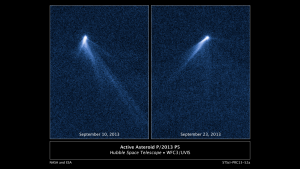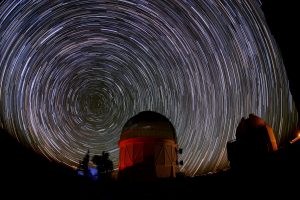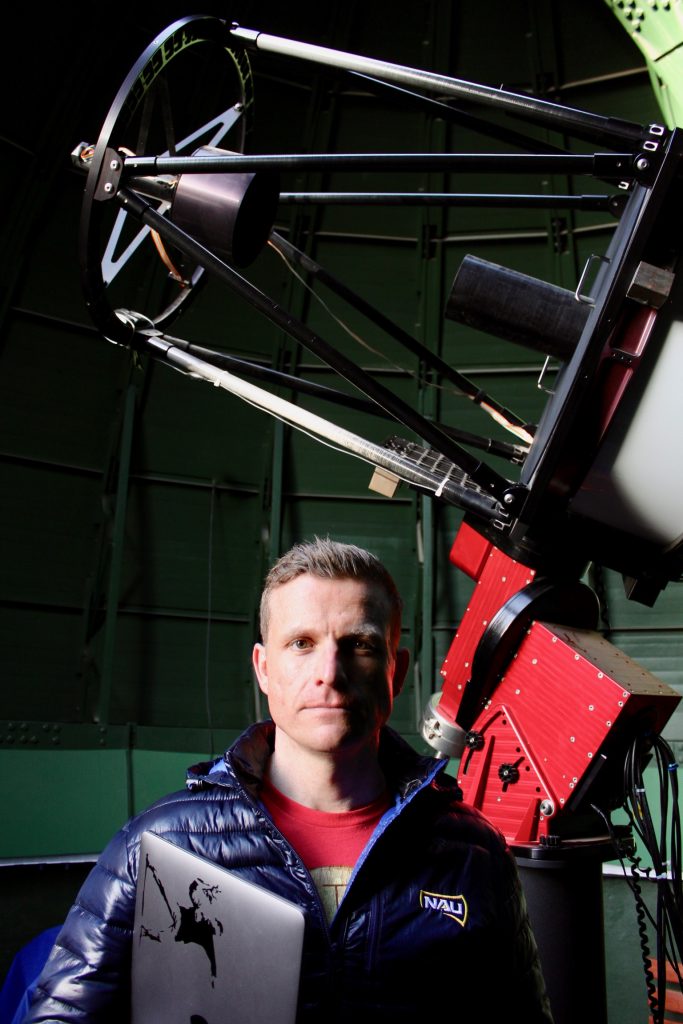By Heidi Toth
NAU Communications
Colin Chandler’s middle name is Orion.
It should be no surprise, then, that at age 7 he was stargazing, or that today, after years owning an IT business in Silicon Valley, he has chosen a career as an astronomer. Like his namesake, he is a celestial hunter, searching space for hints at signs of life on other planets or simply the existence of other planets altogether.
His search just got some help, when Chandler, who is in his second year of the astronomy doctoral program at Northern Arizona University, was awarded a research fellowship from the National Science Foundation—a highly competitive funding opportunity that only 2,000 graduate students throughout the country received this year.
“The NSF fellowship has a long pedigree and a very interesting group of people who have won these awards,” Chandler said. “The thing about this grant that’s very unusual compared to any others is that it’s five pages total, but three of those pages are personal statements and only two are science. They make it very clear: we are looking at the individual as much as or more than the science. The science needs to be cogent and real, and they need to know you can write a science proposal. But clearly, with the ratio, it focuses on the intellectual merit and the broader impact of the individual.”
The impact of Chandler’s work is broad. The Graduate Research Fellowship Program (GRFP), which only about 15 percent of applicants receive, provides three years of funding for his research project, which involves using citizen scientists to review a million or more images of asteroids to determine how many of them may have a tail.
What could this mean for our understanding of the universe? A lot, Chandler said, but it’s bigger than that. This could move forward knowledge about how Earth became a habitable planet and could help astronomers and planetary scientists narrow down life on other planets. See, scientists know that Earth’s water came after the planet was formed, since the process of planetary formation involves thousand-degree temperatures and explosive impacts. But they’re not sure just where the water came from.
Some of it came from comets, Chandler said, which are composed largely of ice. More recent research has questioned whether water came from asteroids, particularly “active” asteroids, meaning they have a tail.
“There are different estimates, but maybe 20 percent of the water on Earth came from comets, depending who you ask,” he said. “But for sure not enough of it came from comets to say it all came from comets. If we can find out there are asteroids with water, that can help answer it.”
If asteroids have water, that may help explain the origin of life on Earth. With the same line of reasoning, asteroids with water that are striking other planets may help create an environment where life can exist on those other planets. They can, essentially, follow the water.
But first, they have to find it.
As of now, astronomers have only identified about 35 asteroids with tails out of several million known space rocks in the universe. It’s not a large enough sample size to make any sort of generalization about the population as a whole. It would be like defining the population of Flagstaff after talking with three residents.

“Once we have them in a regime then we can say, ‘OK, now we can find common traits among these objects,’” Chandler said.
This, he said, is where he needs help. He is working with a huge amount of data that is too big for Chandler to study himself and even too much for a team of a few to analyze. Opening the project up to average citizens with an interest in astronomy allows him to tap into computing power that, as of yet, even the best computers in the world can’t match.
“We would love to be able to automate something like this because it’s a big endeavor, and there are other missions that are going to come online in the future that are going to dwarf the amount of data that we’re talking about,” he said.
His first two steps will begin soon. He needs to access the data—huge pictures taken from a telescope at Cerro Tololo Inter-American Observatory in Chile—and then break down those pictures into thumbnails using Monsoon, NAU’s supercomputer. At the same time, he’ll develop and test a protocol for citizen scientists to follow so he can get reliable data from the project. Although he’s not the first to engage in citizen science, it’s not incredibly common, so much of this protocol will come from testing it out with undergraduate students and members of the community.
This is Chandler’s project, but it’s been largely informed by his work with assistant professor Chad Trujillo, who discovered the still elusive Planet X and studies active asteroids. Chandler also collaborated with David Koerner on stellar ages and continues to do research with David Trilling on the Flagstaff Robotic Survey Telescope (FRoST) and Ty Robinson, his primary adviser, on exoplanets and astrobiology. He’s also working with Stephen Kane at the University of California-Riverside on exoplanet characterization.
Trujillo noted that Chandler has already submitted a paper on what they’ve learned about asteroids from the dark energy camera, and his project now will extend that search to the full public data—about 50 terabytes of imaging data. It is no small task.
“To put that amount into perspective, that is equivalent to streaming movies for 24 hours a day for eight years without interruption,” he said. “Over the course of the proposed work, Colin will analyze most of the 700,000 known asteroids and will probably analyze a million new ones, which is really groundbreaking work.”
The huge project aside, even getting to this point was a process. Robinson, who is in his first year at NAU, organized a workshop to help graduate students prepare for the NSF process, including mock review panels with faculty members and graduate students. Fellowships such as these are highly competitive, and the workshop allows for multiple people in the department to work with students as they move their ideas into a strong, well-presented proposal.

“The GRFP proposal that Colin submitted is a great example of the diversity of approaches that Colin brings to his work—the project spans observational astronomy, big data, supercomputing and citizen science,” Robinson said. “A real strength of Colin’s research process is in his ability to see how seemingly disparate tools or resources can be melded together into a strong, coherent scientific investigation.”
Chandler came to NAU in 2016 after earning his bachelor’s degree in astrophysics at San Francisco State University; he was in the inaugural class of the new Ph.D. program. He came in part because he loved the environment; he likes snow, he felt the astronomy department was supportive and widespread and the week he visited it was Pride Week and Bernie Sanders was campaigning at the Native American Cultural Center on NAU’s Puppy Day. It felt like home. He talked about these experiences and other work he’s done to introduce people to science in his proposal.
Chandler also received a presidential research fellowship, which made getting his doctorate affordable. He has been impressed with how much support President Rita Cheng offers the department, he said.
“I think we all really feel like she’s on our side and really advocating for us in astronomy,” he said.
In the city where Pluto was discovered and researchers are on the front lines in searching for Planet X and life on other planets in addition to protecting life on this planet from an asteroid, all while expanding our knowledge about this universe and the worlds beyond, committing to this program is critical for NAU’s success.
“Our researchers, both students and faculty, are hard at work seeking answers to questions that will change what we know of the world and how we move forward as a society,” Cheng said. “I am proud of Colin and all of our students who applied for the NSF fellowship; they all had great ideas and worked incredibly hard on their proposals, and I know they will continue to engage in groundbreaking research during their time at NAU and throughout their careers.”
Three NAU students also received Honorable Mentions:
- Tia B. Watkins, archaeology
- Jack Torresdal, ecology and conservation biology
- Heather Gillette, ecology



